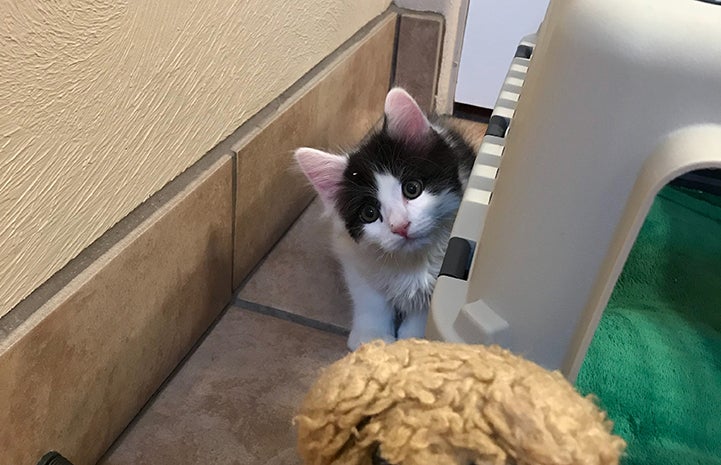Saving kittens at Best Friends’ newest nursery
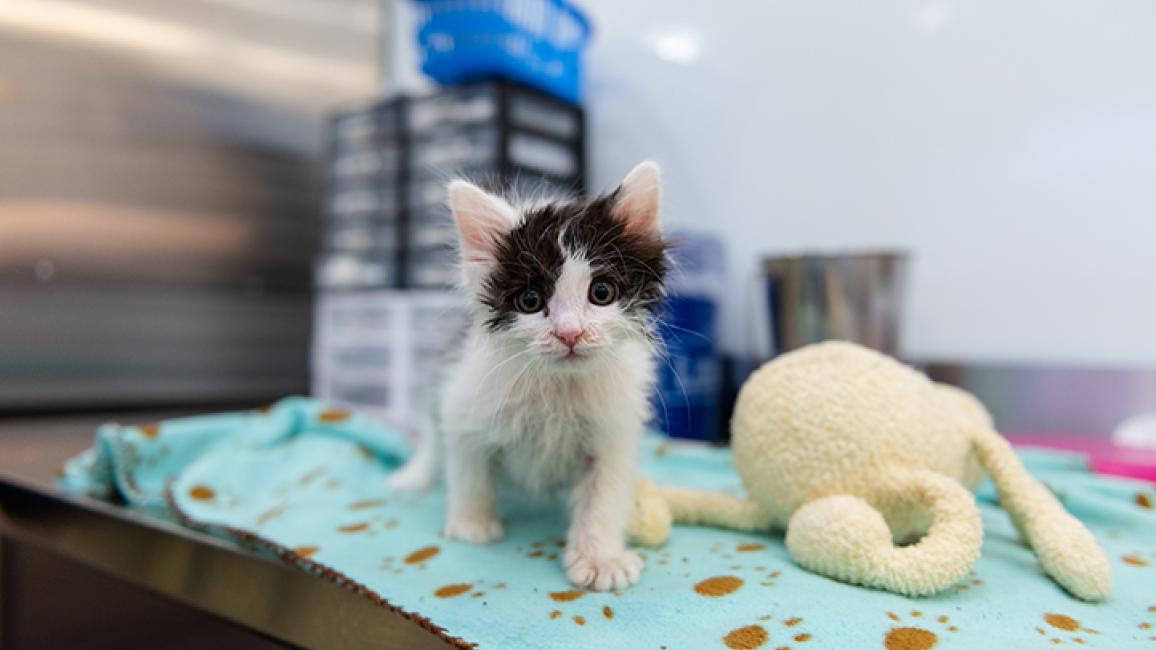
When the new Best Friends Kitten Nursery officially opened on August 11, Oboe was one of the first kittens there. Though the tiny orphaned kitten already had enough personality for a whole litter of kittens, he was still completely dependent on people for his care. But he couldn’t have landed in a better place to get the help and TLC he needed to survive and thrive.
Newborn kitten care
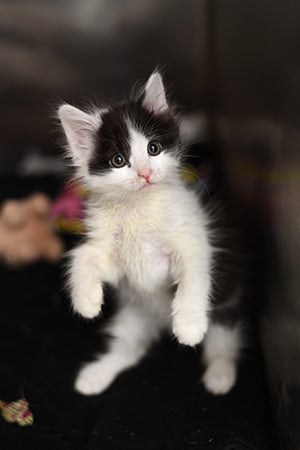 Oboe was just three weeks old when he was brought to Best Friends Animal Society from a small rural shelter. He’d arrived at the shelter alone — with no mother cat to care for him and no siblings.
Oboe was just three weeks old when he was brought to Best Friends Animal Society from a small rural shelter. He’d arrived at the shelter alone — with no mother cat to care for him and no siblings.
Newborn kittens are especially at risk of being killed in shelters, not just because they are too young to take care of themselves, but because newborn kitten care is demanding. Baby cats must be bottle-fed every few hours. They must be kept warm because they can’t regulate their own body temperatures, and they even need help going to the bathroom. Most shelters don’t have the resources to provide this around-the-clock care. And there’s rarely enough space to house kittens for up to two months — the time required until they are big enough to be spayed or neutered and move on to foster or forever homes.
Kittens in shelters are also extremely vulnerable to disease because their immune systems are not yet developed. The shelter where Oboe ended up had recently faced several outbreaks of feline panleukopenia. Panleukopenia symptoms in kittens can include fever, dehydration, loss of appetite, vomiting and diarrhea. If kittens don’t get immediate medical treatment, the virus can be deadly. Whisking Oboe out of the shelter and into the Best Friends Kitten Nursery dramatically increased his chances of survival.
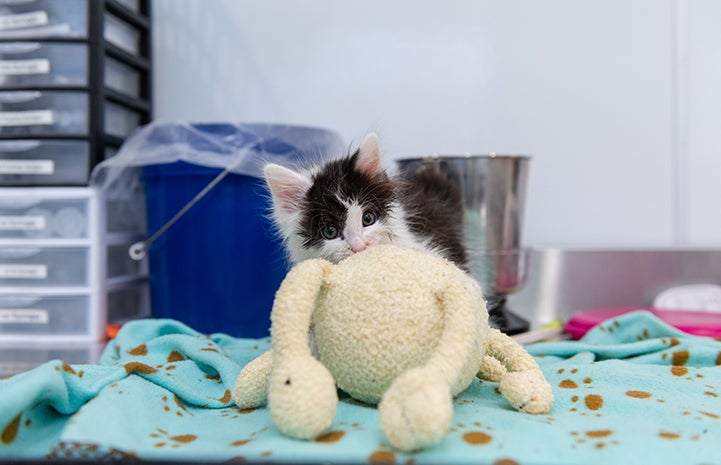
A peek into the new kitten nursery
Though technically part of Cat World, the new nursery is located in the Best Friends Visitor Center in downtown Kanab, just minutes down the road from the Sanctuary. The space is light-filled and sparkling clean. It has several bottle-feeding stations, a separate room to house kittens with contagious illnesses and storage space for everything a growing kitten could possibly need (think piles of fleece blankets, heating discs, formula and food).
There’s a big viewing window so visitors can peek in and see all the good kitten rescue work and care happening there — not to mention all the tiny, adorable balls of fluff. The nursery not only saves lives, but it provides the general public with the eye-opening experience of watching the actual work in progress. Kittens need help everywhere, so when future visitors return home, they’ll be more aware of the issue and more likely to lend a hand to kittens at home.
The nursery was also the perfect place for a little guy like Oboe to grow into the healthy, happy kitten he is today.
Learn more about kitten nurseries
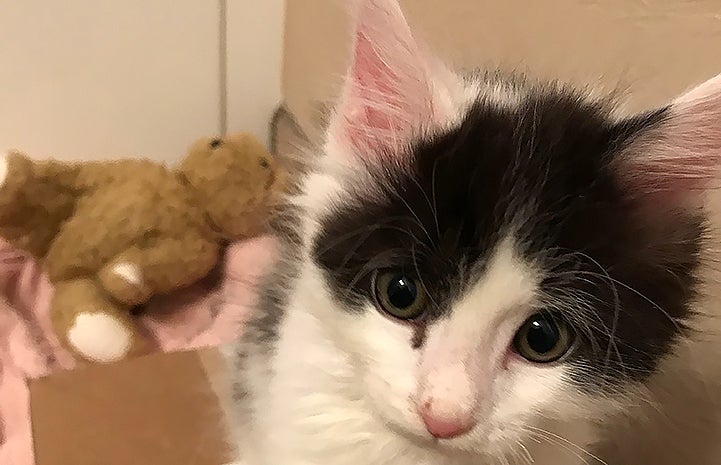
How to care for newborn kittens (bottle babies)
The nursery is set up to provide care for kittens in all three stages of development: bottle babies, weaning kittens and independents.
Kittens up to four weeks old are bottle baby kittens. That’s the stage Oboe was in when he first came to Best Friends. Every two to four hours, one of his caregivers would scoop him up and bring him to a feeding station. There, they would use a soft tissue to help him urinate and defecate, and then clean him up. Then, they’d warm formula in a newborn kitten bottle and hold Oboe in a natural nursing position (on his tummy with his head up) while he drank.
At first, Oboe was a little bit challenging to bottle-feed. The growing kitten had a big appetite, and whenever he couldn’t seem to drink the formula fast enough, he’d get frustrated. Then he’d stop nursing, mew loudly and swipe at the bottle with his tiny paws. But his kind and patient caregivers soothed Oboe and sat with him until he settled down, latched back onto the bottle and drank his fill.
Finally, Oboe would get a gentle massage to help release any air he swallowed, as well as get help going to the bathroom again. Like all bottle babies, Oboe was weighed once a day to make sure he was growing normally and gaining enough weight. When he was done eating, he’d go back to his newly cleaned enclosure, crawl up onto his snuggle (heating) disc and fall asleep. Since he didn’t have any siblings to snuggle up to, caregivers gave Oboe a soft stuffed toy to cuddle. Then in a few hours, the whole process started over again.
How to take care of kittens (weaning and independent)
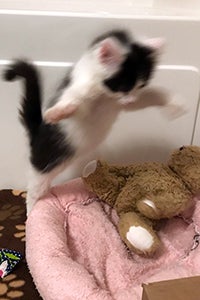 Soon, Oboe was big and strong enough to join the ranks of the weaning kittens at the nursery. Kittens are weaned at three to five weeks, when they’re fed gruel every three to five hours. The gruel (a mixture of formula and canned kitten food) helps kittens transition from formula to kitten food. Things can get a little messy at this stage, so while Oboe was weaning, he frequently would often get covered in food and needed to be wiped up or bathed. In this stage, Oboe also had access to dry food, water and a litter box, just as he’ll eventually have in his future life as an adult cat.
Soon, Oboe was big and strong enough to join the ranks of the weaning kittens at the nursery. Kittens are weaned at three to five weeks, when they’re fed gruel every three to five hours. The gruel (a mixture of formula and canned kitten food) helps kittens transition from formula to kitten food. Things can get a little messy at this stage, so while Oboe was weaning, he frequently would often get covered in food and needed to be wiped up or bathed. In this stage, Oboe also had access to dry food, water and a litter box, just as he’ll eventually have in his future life as an adult cat.
Once he learned to eat wet food out of a bowl, things got a bit tidier for Oboe. As an “independent” kitten (five weeks and up), Oboe was fed regular kitten food (instead of gruel) every five to eight hours. That gave him lots of extra time to practice his stalking and pouncing skills. The soft toy with which he’d spent so many hours cuddling became his playmate as he bounced around his enclosure, leaping onto it and batting at it. He was happy, active and growing up quickly.
How fostering kittens saves lives
Janice Dankert, nursery supervisor, explains that most kittens go into foster homes around six to seven weeks old and stay in foster care until they are eight weeks old and ready to be spayed or neutered. By the time Oboe went to a foster home, he was more than ready to graduate from the nursery and to have more space to run and play. Though he no longer needed round-the-clock care, he’d never before known life in a home. That’s where the foster home comes in.
As Oboe’s foster mom, Cindy Roth adores him. “Oboe is a go-getter and the first to gently discipline unruly toy bears,” says Cindy, a Best Friends community outreach supervisor. “Fostering this rambunctious lad in my home gave him time to stretch his legs and to refine his people skills. Foster homes also afford the kitten nursery staff and volunteers a little extra time to care for their precious fluffy charges.”
Fostering kittens may be fun, but it’s also lifesaving work. That’s because every kitten going to a foster home frees up nursery space, thereby making it possible to help more kittens. The more kittens the nursery can take in, the more lives it saves.
From kitten nursery to kitten adoption
"Every year we have about 170 kittens who need our help to grow into healthy, happy kittens,” says Janice. “Now with our new kitten nursery, we have this safe, sanitary environment where we can care for them. And once these kittens graduate from the nursery, they can be adopted to people anywhere in the United States and Canada.”
That includes feisty, adorable little Oboe, who, Cindy says, already has an adopter lined up. “His kitten nursery antics caught the loving eye of a Best Friends supporter and volunteer who will be welcoming this little fella with the pale pink ears into her home very soon.”
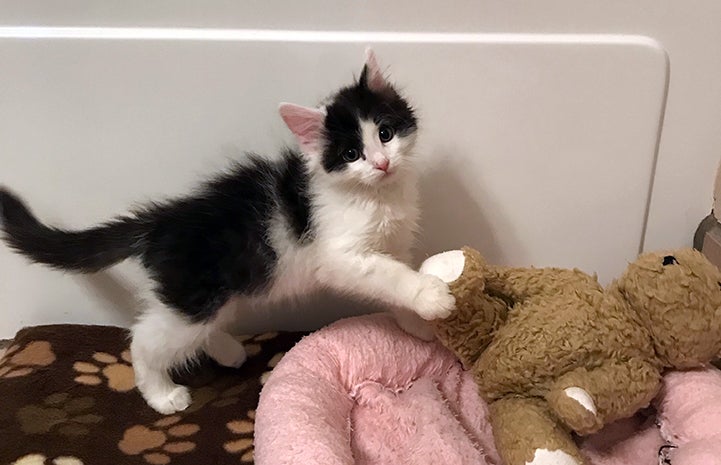
Photos by Sarah Ause Kichas and courtesy of Cindy Roth
